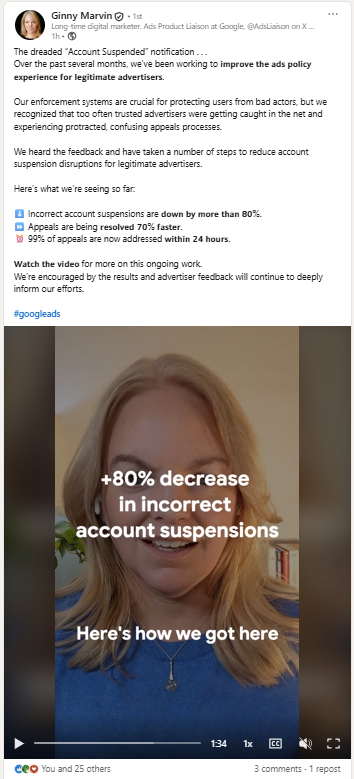Google account suspensions have long been one of the most stressful issues advertisers face. A single notification can pause revenue, disrupt campaigns, and leave teams scrambling to understand what went wrong, often at no fault of their own.
Over the past several months, Google has heard that feedback and is now rolling out measurable improvements aimed at reducing the burden on legitimate advertisers.
These updates should bring meaningful relief. Misapplied suspensions are down, appeals are moving faster, and Google is promising more transparency into why enforcement actions happen at all.
What’s Changed in Google’s Process
Google announced several updates aimed at preventing unnecessary enforcement actions and speeding up resolutions when mistakes happen.
Google Ads Liaison Ginny Marvin shared additional context in a LinkedIn video. She explained that advertisers often faced long, unclear appeal processes. Many of those advertisers were compliant, but still got caught in broad enforcement filters designed to protect users. The new improvements are meant to address that gap and create a smoother experience for legitimate businesses.
 Screenshot taken by author, November 2025
Screenshot taken by author, November 2025According to Google’s data:
- Incorrect account suspensions are down more than 80%
- Appeals are being resolved 70% faster
- 99% of appeals are reviewed within 24 hours
These numbers reflect improvements in Google’s automated systems, better internal checks, and more precise policy evaluation. The goal is to reduce the number of trusted advertisers who get suspended by mistake and to shorten the time it takes to recover when an account needs review.
Google also mentioned ongoing work to make enforcement decisions easier to understand. While full visibility into every signal is unlikely, these updates indicate an effort to give advertisers clearer direction when issues occur.
How This Helps Advertisers
These changes bring meaningful stability to daily operations. When incorrect suspensions drop by such a large margin, advertisers experience fewer unexpected pauses in performance.
That consistency matters for both in-house teams and agencies managing multiple accounts.
The faster appeal timeline also reduces the fallout from any suspension that does occur. Getting nearly all appeals reviewed within a day helps advertisers avoid extended downtime and protects campaign momentum.
Clarity matters as well. Advertisers have long asked for more detail when suspensions happen.
Even small improvements in transparency can save hours of troubleshooting and prevent repeated appeals that contribute to delays.
These updates should also improve confidence in Google’s enforcement systems. When advertisers trust the process, they can focus on optimization instead of worrying that a routine change will trigger a policy issue.
How This Shapes Future Enforcement
Google’s changes reflect a broader effort to balance user protection with a better advertiser experience. Automated enforcement will always play a significant role in preventing harmful behavior, but legitimate businesses need a system that treats them fairly and resolves issues quickly.
The latest results show encouraging progress. There is still room for improvement, especially in policy clarity and long-term consistency, but the direction is positive.
Google has stated that this work will continue and that advertiser feedback remains central to future updates. For marketers, this signals a more stable and predictable enforcement environment, which supports healthier performance and stronger planning across campaigns.


